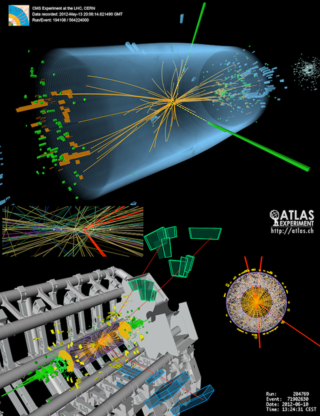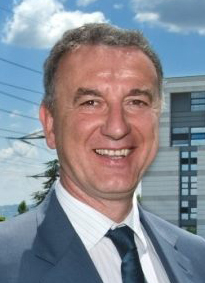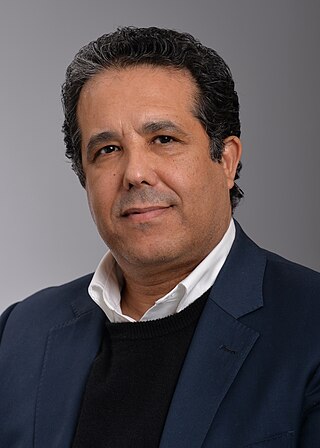
Guido Tonelli (born 1950) is an Italian particle physicist who was involved with the discovery of the Higgs boson at the Large Hadron Collider. [1] He is a professor of General Physics at the University of Pisa (Italy) and a CERN visiting scientist.

Guido Tonelli (born 1950) is an Italian particle physicist who was involved with the discovery of the Higgs boson at the Large Hadron Collider. [1] He is a professor of General Physics at the University of Pisa (Italy) and a CERN visiting scientist.
He was born in Casola in Lunigiana, Italy, on 8 November 1950. He received his high school diploma in 1969 at the liceo classico Lorenzo Costa of La Spezia with a vote of 60/60. Subsequently, he received his degree in physics in 1975 at the University of Pisa (with a vote of 110/110), Italy where he became professor in 1992. Since 1976 he works in the field of high energy physics, participating in CERN experiments NA1, NA7 and ALEPH, and in the CDF experiment at Fermilab, Batavia (IL-USA). Among his contributions there are the first precision measurements of the lifetime of charmed mesons, precision tests of the Standard Model of the fundamental interactions, search for the Higgs boson, and for various signatures of Supersymmetry or new physics beyond the Standard Model.
Since the beginning of the '90 his activity is mainly devoted to the Compact Muon Solenoid (CMS), experiment proposed for the Large Hadron Collider (LHC) at CERN, Geneva, (Switzerland). He participates in CMS since the conceptual design contributing with the original idea of a central tracker fully based on semiconductor devices. [2] He is elected as CMS Spokesperson for the years 2010-2011. [3]
On 13 December 2011 together with Fabiola Gianotti, ATLAS Spokesperson, he presented in a special seminar at CERN the first evidence of the presence of the Higgs boson around a mass of 125 GeV/c2. [4] The 125GeV signal appears again in the new data collected in spring 2012, and, combining the 7 TeV 2011 data with the 8TeV, 2012 data, the statistical significance of the signal reaches the conventional 5 sigma threshold needed to announce a new discovery. Therefore, on 4 July 2012, the ATLAS and CMS experiments announce formally the observation of a new Higgs-like boson at LHC. [5]
On 14 March 2013 new results presented by ATLAS and CMS at the Moriond Conference in La Thuile confirm that all observations are consistent with the hypothesis the observed particle being the Standard Model Higgs boson. [6]
Thanks to this discovery, on 8 October 2013 the Nobel Prize in Physics 2013 was assigned to François Englert and Peter Higgs with the motivation "for the theoretical discovery of a mechanism that contributes to our understanding of the origin of mass of subatomic particles, and which recently was confirmed through the discovery of the predicted fundamental particle, by the ATLAS and CMS experiments at CERN's Large Hadron Collider". [7]

The European Organization for Nuclear Research, known as CERN, is an intergovernmental organization that operates the largest particle physics laboratory in the world. Established in 1954, it is based in Meyrin, western suburb of Geneva, on the France–Switzerland border. It comprises 23 member states. Israel, admitted in 2013, is the only non-European full member. CERN is an official United Nations General Assembly observer.

The Tevatron was a circular particle accelerator in the United States, at the Fermi National Accelerator Laboratory, east of Batavia, Illinois, and was the highest energy particle collider until the Large Hadron Collider (LHC) of the European Organization for Nuclear Research (CERN) was built near Geneva, Switzerland. The Tevatron was a synchrotron that accelerated protons and antiprotons in a 6.28 km (3.90 mi) circumference ring to energies of up to 1 TeV, hence its name. The Tevatron was completed in 1983 at a cost of $120 million and significant upgrade investments were made during its active years of 1983–2011.

The Compact Muon Solenoid (CMS) experiment is one of two large general-purpose particle physics detectors built on the Large Hadron Collider (LHC) at CERN in Switzerland and France. The goal of the CMS experiment is to investigate a wide range of physics, including the search for the Higgs boson, extra dimensions, and particles that could make up dark matter.

The Large Hadron Collider (LHC) is the world's largest and highest-energy particle collider. It was built by the European Organization for Nuclear Research (CERN) between 1998 and 2008 in collaboration with over 10,000 scientists and hundreds of universities and laboratories across more than 100 countries. It lies in a tunnel 27 kilometres (17 mi) in circumference and as deep as 175 metres (574 ft) beneath the France–Switzerland border near Geneva.

ATLAS is the largest general-purpose particle detector experiment at the Large Hadron Collider (LHC), a particle accelerator at CERN in Switzerland. The experiment is designed to take advantage of the unprecedented energy available at the LHC and observe phenomena that involve highly massive particles which were not observable using earlier lower-energy accelerators. ATLAS was one of the two LHC experiments involved in the discovery of the Higgs boson in July 2012. It was also designed to search for evidence of theories of particle physics beyond the Standard Model.

The Large Electron–Positron Collider (LEP) was one of the largest particle accelerators ever constructed. It was built at CERN, a multi-national centre for research in nuclear and particle physics near Geneva, Switzerland.

The Higgs boson, sometimes called the Higgs particle, is an elementary particle in the Standard Model of particle physics produced by the quantum excitation of the Higgs field, one of the fields in particle physics theory. In the Standard Model, the Higgs particle is a massive scalar boson with zero spin, even (positive) parity, no electric charge, and no colour charge that couples to mass. It is also very unstable, decaying into other particles almost immediately upon generation.

Fabiola Gianotti is an Italian experimental particle physicist who is the current and first woman Director-General at CERN in Switzerland. Her first mandate began on 1 January 2016 and ran for a period of five years. At its 195th Session in 2019, the CERN Council selected Gianotti for a second term as Director-General. Her second five-year term began on 1 January 2021 and goes on until 2025. This is the first time in CERN's history that a Director-General has been appointed for a full second term.
Joseph Incandela is an American particle physicist, a professor of physics at the University of California, Santa Barbara and currently based at CERN, where he spent two years as the spokesperson for the Compact Muon Solenoid experiment at the Large Hadron Collider.

The search for the Higgs boson was a 40-year effort by physicists to prove the existence or non-existence of the Higgs boson, first theorised in the 1960s. The Higgs boson was the last unobserved fundamental particle in the Standard Model of particle physics, and its discovery was described as being the "ultimate verification" of the Standard Model. In March 2013, the Higgs boson was officially confirmed to exist.

Sir Tejinder Singh Virdee,, is a Kenyan-born British experimental particle physicist and Professor of Physics at Imperial College London. He is best known for originating the concept of the Compact Muon Solenoid (CMS) with a few other colleagues and has been referred to as one of the 'founding fathers' of the project. CMS is a world-wide collaboration which started in 1991 and now has over 3500 participants from 45 countries.

Sau Lan Wu is a Chinese American particle physicist and the Enrico Fermi Distinguished Professor of Physics at the University of Wisconsin-Madison. She made important contributions towards the discovery of the J/psi particle, which provided experimental evidence for the existence of the charm quark, and the gluon, the vector boson of the strong force in the Standard Model of physics. Recently, her team located at the European Organization for Nuclear Research (CERN), using data collected at the Large Hadron Collider (LHC), was part of the international effort in the discovery of a boson consistent with the Higgs boson.

Peter Jenni, is an experimental particle physicist working at CERN. He is best known as one of the "founding fathers" of the ATLAS experiment at the CERN Large Hadron Collider together with a few other colleagues. He acted as spokesperson of the ATLAS Collaboration until 2009. ATLAS is a world-wide collaboration which started in 1992 involving roughly 3,000 physicists at 183 institutions in 38 countries. Jenni was directly involved in the experimental work leading to the discoveries of the W and Z bosons in the 1980s and the Higgs boson in 2012. He is (co-)author of about 1000 publications in scientific journals.

Lucio Rossi is an Italian physicist who is working in the field of superconductivity. He has been working since 2001 at CERN, on leave from the University of Milan, where he directed the Magnets & Superconductors for the LHC project, worth €1.7 billion, half of the machine's entire budget. He was the project leader of the HL-LHC project.

Ashutosh Vijay Kotwal is an American particle physicist of Indian origin. He is the Fritz London Professor of Physics at Duke University, and conducts research in particle physics related to W bosons and the Higgs boson and searches for new particles and forces.
Michel Della Negra is a French experimental particle physicist known for his role in the 2012 discovery of the Higgs Boson.

]

Kamal Benslama is a Moroccan-Swiss experimental particle physicist. He is a professor of physics at Drew University, a visiting experimental scientist at Fermilab, and a guest scientist at Brookhaven National Laboratory. He worked on the ATLAS experiment, at the Large Hadron Collider (LHC) at CERN in Switzerland, which is considered the largest experiment in the history of physical science. At present, he is member of the MU2E collaboration at Fermi National Accelerator Laboratory (Fermilab), located just outside Batavia, Illinois, near Chicago. Fermilab is a United States Department of Energy national laboratory specializing in high-energy particle physics.
Oliver Buchmueller is a scientist and professor of physics at the Faculty of Natural Science, Imperial College London. Buchmueller is presently serving as one of the lead scientists on the Compact Muon Solenoid experiment at CERN’s Large Hadron Collider, the principal investigator of the Atom Interferometer Observatory and Network and also one of the lead authors at Atomic Experiment for Dark Matter and Gravity Exploration in Space (AEDGE). Previously he has been associated with the ALEPH experiment at CERN’s LEP collider and the BaBar experiment at SLAC. Buchmueller was among the group of scientists responsible for the discovery of Higgs Boson particle at the LHC, CERN and later in the scientific exploration to find the traces of dark matter through the LHC.
Geoffrey Hall, is a British particle physicist, currently Professor of Physics at Imperial College London. He is best known for developing radiation and particle detectors and other electronic instruments for use in particle physics experiments, notably the CMS detector in CERN's Large Hadron Collider.
{{cite web}}: CS1 maint: archived copy as title (link){{cite web}}: CS1 maint: archived copy as title (link){{cite book}}: CS1 maint: date and year (link)